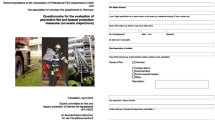Abstract
Experience with fire safety engineering under a performance-based fire safety regulation regime shows that the majority of the analyses performed are scenario based. A comparison with purely pre-accepted performance requirement is made in order to assess the relative safety level of the alternative design compared with the pre-accepted design. We find this approach problematic because it undermines the value of performing analyses. The approach accepts oversimplification and justifies unrealistic assumptions on the basis that it will not affect the comparison. This distances the analyses from reality and reduces their value to answer a yes/no question on acceptability. The considerable time and resources spent on searching for and analyzing a pre-accepted design could be spent on analyzing the design at hand. If fire safety analyses are to have any real impact on design, it is necessary that regulators strengthen the position of analytical design. This must include a provision of a clear set of performance goals, which are possible to transform into quantitative evaluation criteria by the engineers, to avoid comparisons with pre-accepted performance requirements.



Similar content being viewed by others
References
BE (2000) Guideline on smoke ventilation (in Norwegian). National Office of Building Technology and Administration (BE), Oslo
Bjelland H, Njå O (2012a) Fourteen years of experience with performance-based fire safety engineering in Norway—lessons learned. Paper presented at the 9th international conference on performance-based code and fire safety design methods, The Excelsior Hong Kong, 20–22 June 2012
Bjelland H, Njå O (2012b) Interpretation of safety margin in ASET/RSET Assessments in the Norwegian building industry. Paper presented at the European safety and reliability conference (ESREL 2012), Helsinki, Finland, 25–29 June 2012
Bjelland H, Njå O (2012c) Performance-based fire safety: risk associated with different designs. Paper presented at the advances in safety, reliability and risk management: proceedings of the European safety and reliability conference, ESREL 2011, Troyes, France, 18–22 September 2011
Boverket (2011) Boverkets allmänna råd 2011:xx. Vägledning i analytisk dimensionering av byggnaders brandskydd (in Swedish). Boverket, Oktober 2011
DBH (2012) C/VM2 verification method: framework for fire safety design. For New Zealand building code clauses C1–C6 protection from fire. New Zealand Government, Department of Building and Housing, Wellington
DiBK (2010) Guide to the building regulations of 2010. The Directorate of Building Quality, Oslo
Emmons HW (1990) Firesafety science—the promise of a better future. Fire Technol 26(1):5–15
Frantzich H (1998) Risk analysis and fire safety engineering. Fire Saf J 31(4):313–329
Friedman R (1990) Fire protection engineering—science or art? J Fire Prot Eng 2(1):25–29
Hadjisophocleous GV, McCartney CJ (2005) Guidelines for the use of CFD simulations for fire and smoke modeling. ASHRAE Transactions 111(2):583–594
Hall JR, Sekizawa A (1991) Fire risk analysis: general conceptual framework for describing models. Fire Technol 27(1):33–53
ISO (2006) ISO/TS 16733:2006 Fire safety engineering—selection of design fire scenarios and design fires. International Organization for Standardization, French Standard Institute (AFNOR), Geneva
ISO (2009) ISO/TR 16738:2009 (E) Fire-safety engineering—technical information on methods for evaluating behavior and movement of people. International Organization for Standardization, Geneva
Lucht DA (1989) Coming of age. J Fire Prot Eng 1(2):35–48
Lucht DA (1992) Changing the way we do business. Fire Technol 28(3):271–276
McGrattan K, Hostikka S, Floyd F, Baum H, Rehm R (2007) Fire dynamics simulator (version 5) technical reference guide. National Institute of Standards and Technology (NIST) Special Publication 1018-5, Washington
McGrattan K, McDermott R, Hostikka S, Floyd J (2010) Fire dynamics simulator (version 5) user’s guide. National Institute of Standards and Technology (NIST) Special Publication 1019-5, Washington
Meacham BJ, Custer RLP (1995) Performance-based fire safety engineering: an introduction of basic concepts. J Fire Prot Eng 7(2):35–54
NBRI (2006) 520.380 Smoke control in buildings (in Norwegian). Norwegian Building Research Institute, Oslo
NRC US (2007) Verification and Validation of Selected Fire Models for Nuclear Power Plant Applications, Volume 7: Fire Dynamics Simulator (FDS). U.S. Nuclear Regulatory Commission, Office of Nuclear Regulatory Research (RES), Rockville, MD and Electric Power Research Institute (EPRI), Palo Alto
RI NB (2006) 520.385 Required safe egress time in fire situations (in Norwegian). Norwegian Building Research Institute, Oslo
SFPE (2000) SFPE engineering guide to performance-based fire protection analysis and design of buildings. NFPA, Quincy
Watts Jr JM (1988) Fire risk analysis (editorial). Fire Technol 24(4):289–290
Acknowledgments
The authors are grateful to two anonymous reviewers for valuable comments to the original version of this paper.
Conflict of interest
None.
Author information
Authors and Affiliations
Corresponding author
Rights and permissions
About this article
Cite this article
Bjelland, H., Borg, A. On the use of scenario analysis in combination with prescriptive fire safety design requirements. Environ Syst Decis 33, 33–42 (2013). https://doi.org/10.1007/s10669-012-9425-2
Published:
Issue Date:
DOI: https://doi.org/10.1007/s10669-012-9425-2




